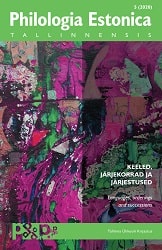Muutevormide ilmumine eesti keelt esimese keelena omandavate laste kõnesse
Emergence and Productive Use of Inflectional Forms in Early Estonian
Author(s): Reili Argus, Annika BauerSubject(s): Phonetics / Phonology, Morphology, Syntax, Language acquisition, Finno-Ugrian studies
Published by: Tallinna Ülikooli Kirjastus
Keywords: acquisition of inflectional morphphology; exemplars; productive use of forms; inflections;
Summary/Abstract: The goal of this paper is to describe the first emergence and productive use of inflectional forms in the speech of three Estonian-speaking children and provide the order of the emergence of different inflectional categories. Spontaneous data from three children aged 1;3–5;8 have been used to determine which noun, verb and adjective categories emerge first and which morphophonological features of first exemplars (stems used first in different inflectional forms) play a role in the acquisition of Estonian. The first inflectional categories acquired by the children in question were in grammatical cases, the imperative and first person singular present tense forms. Concerning the productively used forms, it can be argued that the number of verb forms increases rapidly while the acquisition of noun forms is slower. Some case forms were even not registered in the speech material of the children. The children started to use comparative degrees of adjectives quite late compared to adjectival case forms. It seems that the children acquired the core of Estonian grammar at the same time. The further order of acquisition of inflectional forms was different in the speech of the three children in question. Still, the differences in the order of emergence of forms can be caused by the different frequency of some forms: if the inflectional form is infrequent also in the speech of adults it can just be that the form is not present in recordings but the child could still use it; therefore, evidence of the order of emergence of infrequent forms can be quite occasional in the data presented here. The first exemplars with distinguishable morphophonological features could be detected only in the case of nouns. The first nouns used for early case forms could be divided into two prototypical morphophonological class: nouns with monosyllabic strong grade stem in the nominative and disyllabic nouns without grade alternation. Clear-cut morphophonological distinctions could not be identified in case of verbs and adjectives.
Journal: Philologia Estonica Tallinnensis
- Issue Year: 5/2020
- Issue No: 1
- Page Range: 17-58
- Page Count: 42
- Language: Estonian

